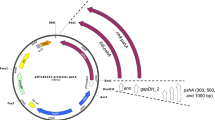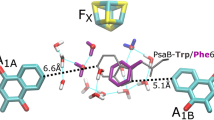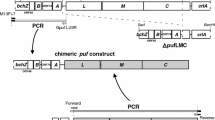Abstract
The anoxygenic phototrophic bacterium Heliobacterium modesticaldum contains a photochemical reaction center protein complex (called the HbRC) consisting of a homodimer of the PshA polypeptide and two copies of a newly discovered polypeptide called PshX, which is a single transmembrane helix that binds two bacteriochlorophyll g molecules. To assess the function of PshX, we produced a ∆pshX strain of Hbt. modesticaldum by leveraging the endogenous Hbt. modesticaldum Type I-A CRISPR-Cas system to aid in mutant selection. We optimized this system by separating the homologous recombination and CRISPR-based selection steps into two plasmid transformations, allowing for markerless gene replacement. Fluorescence and low-temperature absorbance of the purified HbRC from the wild-type and ∆pshX strains showed that the bacteriochlorophylls bound by PshX have the lowest site energies in the entire HbRC. This indicates that PshX acts as a low-energy antenna subunit, participating in entropy-assisted uphill energy transfer toward the P800 special bacteriochlorophyll g pair. We further discuss the role that PshX may play in stability of the HbRC, its conservation in other heliobacterial species, and the evolutionary pressure to produce and maintain single-TMH subunits in similar locations in other reaction centers.









Similar content being viewed by others
References
Asao M, Madigan MT (2010) Taxonomy, phylogeny, and ecology of the heliobacteria. Photosynth Res 104:103–111. https://doi.org/10.1007/s11120-009-9516-1
Baker PL, Orf GS, Kevershan K, Pyne ME, Bicer T, Redding KE (2019a) Using the endogenous CRISPR-Cas system of Heliobacterium modesticaldum to delete the photochemical reaction center core subunit gene. Appl Environ Microbiol 85:e01644-e1719. https://doi.org/10.1128/AEM.01644-19
Baker PL, Orf GS, Khan Z, Espinoza L, Leung S, Kevershan K, Redding KE (2019b) A molecular biology tool kit for the phototrophic firmicute Heliobacterium modesticaldum. Appl Environ Microbiol 85:e01287-e1319. https://doi.org/10.1128/AEM.01287-19
Beer-Romero P, Gest H (1987) Heliobacillus mobilis, a peritrichously flagellated anoxyphototroph containing bacteriochlorophyll g. FEMS Microbiol Lett 41:109–114. https://doi.org/10.1111/j.1574-6968.1987.tb02179.x
Blankenship RE (2014) Molecular mechanisms of photosynthesis, 2nd edn. Wiley, Chicester
Brezovský J, Kozlíková B, Damborský J (2018) Computational analysis of protein tunnels and channels. In: Bornscheuer UT, Hohne M (eds) Protein engineering: methods and protocols, methods in molecular biology. Springer, New York, pp 25–42. https://doi.org/10.1007/978-1-4939-7366-8_3
Bryant DA, Canniffe DP (2018) How nature designs light-harvesting antenna systems: design principles and functional realization in chlorophototrophic prokaryotes. J Phys B at Mol Opt Phys 51:033001. https://doi.org/10.1088/1361-6455/aa9c3c
Bryant DA, Frigaard N-U (2006) Prokaryotic photosynthesis and phototrophy illuminated. Trends Microbiol 14:488–496. https://doi.org/10.1016/j.tim.2006.09.001
Cardona T (2015) A fresh look at the evolution and diversification of photochemical reaction centers. Photosynth Res 126:111–134. https://doi.org/10.1007/s11120-014-0065-x
Cardona T (2016) Reconstructing the origin of oxygenic photosynthesis: do assembly and photoactivation recapitulate evolution? Front Plant Sci 7:1–16. https://doi.org/10.3389/fpls.2016.00257
Cardona T, Sedoud A, Cox N, Rutherford AW (2012) Charge separation in Photosystem II: a comparative and evolutionary overview. Biochim Biophys Acta—Bioenerg 1817:26–43. https://doi.org/10.1016/j.bbabio.2011.07.012
Chauvet A, Sarrou J, Lin S, Romberger SP, Golbeck JH, Savikhin S, Redding KE (2013) Temporal and spectral characterization of the photosynthetic reaction center from Heliobacterium modesticaldum. Photosynth Res 116:1–9. https://doi.org/10.1007/s11120-013-9871-9
Chevallet M, Luche S, Rabilloud T (2006) Silver staining of proteins in polyacrylamide gels. Nat Protoc 1:1852–1858. https://doi.org/10.1038/nprot.2006.288
Dewey ED, Stokes LM, Burchell BM, Shaffer KN, Huntington AM, Baker JM, Nadendla S, Giglio MG, Bender KS, Touchman JW, Blankenship RE, Madigan MT, Sattley WM (2020) Analysis of the complete genome of the alkaliphilic and phototrophic firmicute Heliorestis convoluta strain HHT. Microorganisms 8:313. https://doi.org/10.3390/microorganisms8030313
Edgar RC (2004) MUSCLE: multiple sequence alignment with high accuracy and high throughput. Nucleic Acids Res 32:1792–1797. https://doi.org/10.1093/nar/gkh340
Ferlez BH, Cowgill JB, Dong W, Gisriel C, Lin S, Flores M, Walters K, Cetnar D, Redding KE, Golbeck JH (2016) Thermodynamics of the electron acceptors in Heliobacterium modesticaldum: an exemplar of an early homodimeric type I photosynthetic reaction center. Biochemistry 55:2358–2370. https://doi.org/10.1021/acs.biochem.5b01320
Gisriel C, Sarrou I, Ferlez B, Golbeck JH, Redding KE, Fromme R (2017) Structure of a symmetric photosynthetic reaction center-photosystem. Science 357:1021–1025. https://doi.org/10.1126/science.aan5611
Gisriel C, Shen G, Kurashov V, Ho M, Zhang S, Williams D, Golbeck JH, Fromme P, Bryant DA (2020) The structure of Photosystem I acclimated to far-red light illuminates an ecologically important acclimation process in photosynthesis. Sci Adv 6:eaay6415. https://doi.org/10.1126/sciadv.aay6415
Hansson A, Amann K, Zygadlo A, Meurer J, Scheller HV, Jensen PE (2007) Knock-out of the chloroplast-encoded PSI-J subunit of photosystem I in Nicotiana tabacum. FEBS J 274:1734–1746. https://doi.org/10.1111/j.1742-4658.2007.05722.x
Heap JT, Pennington OJ, Cartman ST, Minton NP (2009) A modular system for Clostridium shuttle plasmids. J Microbiol Methods 78:79–85. https://doi.org/10.1016/j.mimet.2009.05.004
Hohmann-Marriott MF, Blankenship RE (2011) Evolution of photosynthesis. Annu Rev Plant Biol 62:515–548. https://doi.org/10.1146/annurev-arplant-042110-103811
Jordan P, Fromme P, Witt HT, Klukas O, Saenger W, Krauss N (2001) Three-dimensional structure of cyanobacterial photosystem I at 2.5 A resolution. Nature 411:909–917. https://doi.org/10.1038/35082000
Karapetyan NV, Schlodder E, van Grondelle R, Dekker JP (2006) The long wavelength chlorophylls of photosystem I. In: Golbeck JH (ed) Photosystem I: advances in photosynthesis and respiration. Springer, Dordrecht, pp 177–192. https://doi.org/10.1007/978-1-4020-4256-0_13
Kashey TS, Luu DD, Cowgill JC, Baker PL, Redding KE (2018) Light-driven quinone reduction in heliobacterial membranes. Photosynth Res. https://doi.org/10.1007/s11120-018-0496-x
Kato K, Shinoda T, Nagao R, Akimoto S, Suzuki T, Dohmae N, Chen M, Allakhverdiev SI, Shen JR, Akita F, Miyazaki N, Tomo T (2020) Structural basis for the adaptation and function of chlorophyll f in photosystem I. Nat Commun 11:1–10. https://doi.org/10.1038/s41467-019-13898-5
Kimble LK, Mandelco L, Woese CR, Madigan MT (1995) Heliobacterium modesticaldum, sp. nov., a thermophilic heliobacterium of hot springs and volcanic soils. Arch Microbiol 163:259–267. https://doi.org/10.1007/BF00393378
Kimura A, Itoh S (2018) Theoretical model of exciton states and ultrafast energy transfer in heliobacterial type I homodimeric reaction center. J Phys Chem B 122:11852–11859. https://doi.org/10.1021/acs.jpcb.8b08014
Kitoh-Nishioka H, Shigeta Y, Itoh S, Kimura A (2020) Excitonic coupling on a heliobacterial symmetrical type-I reaction center: comparison with photosystem I. J Phys Chem B 124:389–403. https://doi.org/10.1021/acs.jpcb.9b11290
Kleinherenbrink FAM, Ikegami I, Hiraishi A, Otte SCM, Amesz J (1993) Electron transfer in menaquinone-depleted membranes of Heliobacterium chlorum. Biochim Biophys Acta—Bioenerg 1142:69–73. https://doi.org/10.1016/0005-2728(93)90085-T
Kumar S, Stecher G, Li M, Knyaz C, Tamura K (2018) MEGA X: molecular evolutionary genetics analysis across computing platforms. Mol Biol Evol 35:1547–1549. https://doi.org/10.1093/molbev/msy096
Liebl U, Mockensturm-Wilson M, Trost JT, Brune DC, Blankenship RE, Vermaas WFJ (1993) Single core polypeptide in the reaction center of the photosynthetic bacterium Heliobacillus mobilis: structural implications and relations to other Photosystems. Proc Natl Acad Sci U S A 90:7124–7128
Litvín R, Bína D, Herbstová M, Pazderník M, Kotabová E, Gardian Z, Trtílek M, Prášil O, Vácha F (2019) Red-shifted light-harvesting system of freshwater eukaryotic alga Trachydiscus minutus (Eustigmatophyta, Stramenopila). Photosynth Res 142:137–151. https://doi.org/10.1007/s11120-019-00662-5
Miyamoto R, Iwaki M, Hiroyuki Mino, Harada J, Itoh S, Oh-oka H (2006) XHeliobacterium modesticaldum. Biochemistry 45(20):6306–6316. https://doi.org/10.1021/bi0519710
Nelson N, Yocum CF (2006) Structure and function of photosystems I and II. Annu Rev Plant Biol 57:521–565. https://doi.org/10.1146/annurev.arplant.57.032905.105350
Orf GS, Redding KE (2019) Expression and purification of affinity-tagged variants of the photochemical reaction center from Heliobacterium modesticaldum. Photosynth Res 142:335–348. https://doi.org/10.1007/s11120-019-00672-3
Orf GS, Gisriel C, Redding KE (2018) Evolution of photosynthetic reaction centers: insights from the structure of the heliobacterial reaction center. Photosynth Res 138:11–37. https://doi.org/10.1007/s11120-018-0503-2
Pan J, Saer RG, Lin S, Beatty JT, Woodbury NW (2016) Electron transfer in bacterial reaction centers with the photoactive bacteriopheophytin replaced by a bacteriochlorophyll through coordinating ligand substitution. Biochemistry 55:4909–4918. https://doi.org/10.1021/acs.biochem.6b00317
Pyne ME, Bruder M, Moo-Young M, Chung DA, Chou CP (2014) Technical guide for genetic advancement of underdeveloped and intractable Clostridium. Biotechnol Adv 32:623–641. https://doi.org/10.1016/j.biotechadv.2014.04.003
Pyne ME, Bruder MR, Moo-Young M, Chung DA, Chou CP (2016) Harnessing heterologous and endogenous CRISPR-Cas machineries for efficient markerless genome editing in Clostridium. Sci Rep 6:25666. https://doi.org/10.1038/srep25666
Rutherford AW, Mattiolo TA, Nitschke W (1996) The FeS-type photosystems and the evolution of photosynthetic reaction centers. In: Baltscheffsky H (ed) Origin and evolution of biological energy conversion. VCH Publications, New York, pp 177–204
Sadekar S, Raymond J, Blankenship RE (2006) Conservation of distantly related membrane proteins: photosynthetic reaction centers share a common structural core. Mol Biol Evol 23:2001–2007. https://doi.org/10.1093/molbev/msl079
Sarrou I, Khan Z, Cowgill JB, Lin S, Brune DC, Romberger SP, Golbeck JH, Redding KE (2012) Purification of the photosynthetic reaction center from Heliobacterium modesticaldum. Photosynth Res 111:291–302. https://doi.org/10.1007/s11120-012-9726-9
Sattley WM, Madigan MT, Swingley WD, Cheung PC, Clocksin KM, Conrad AL, Dejesa LC, Honchak BM, Jung DO, Karbach LE, Kurdoglu A, Lahiri S, Mastrian SD, Page LE, Taylor HL, Wang ZT, Raymond J, Chen M, Blankenship RE, Touchman JW (2008) The genome of Heliobacterium modesticaldum, a phototrophic representative of the Firmicutes containing the simplest photosynthetic apparatus. J Bacteriol 190:4687–4696. https://doi.org/10.1128/JB.00299-08
Sattley WM, Blankenship RE (2010) Insights into heliobacterial photosynthesis and physiology from the genome of Heliobacterium modesticaldum. Photosynth Res 104(2–3):113–122. https://doi.org/10.1007/s11120-010-9529-9
Schägger H (2006) Tricine–SDS-PAGE. Nat Protoc 1:16–22. https://doi.org/10.1038/nprot.2006.4
Schmitt F-J, Campbell ZY, Bui MV, Hüls A, Tomo T, Chen M, Maksimov EG, Allakhverdiev SI, Friedrich T (2019) Photosynthesis supported by a chlorophyll f-dependent, entropy-driven uphill energy transfer in Halomicronema hongdechloris cells adapted to far-red light. Photosynth Res 139:185–201. https://doi.org/10.1007/s11120-018-0556-2
Sheehy D, Lu Y-K, Osman F, Alattar Z, Flores C, Sussman H, Zaare S, Dooling M, Meraban A, Baker P, Touchman JW, Redding KE (2018) Genome-wide transcriptional response during the shift to N2-fixing conditions in Heliobacterium modesticaldum. J Proteomics Bioinform 11:143–160. https://doi.org/10.4172/jpb.1000481
Song Y, Sechrist R, Nguyen HH, Johnson W, Abramavicius D, Redding KE, Ogilvie JP (2021) Excitonic structure and charge separation in the heliobacterial reaction center probed by multispectral multidimensional spectroscopy. Nat Commun. https://doi.org/10.1038/s41467-021-23060-9
Structural Genomics Consortium, China Structural Genomics Consortium, Northeast Structural Genomics Consortium, Gräslund S, Nordlund P, Weigelt J, Hallberg BM, Bray J, Gileadi O, Knapp S, Oppermann U, Arrowsmith C, Hui R, Ming J, Dhe-Paganon S, Park H, Savchenko A, Yee A, Edwards A, Vincentelli R, Cambillau C, Kim R, Kim S-H, Rao Z, Shi Y, Terwilliger TC, Kim C-Y, Hung L-W, Waldo GS, Peleg Y, Albeck S, Unger T, Dym O, Prilusky J, Sussman JL, Stevens RC, Lesley SA, Wilson IA, Joachimiak A, Collart F, Dementieva I, Donnelly MI, Eschenfeldt WH, Kim Y, Stols L, Wu R, Zhou M, Burley SK, Emtage JS, Sauder JM, Thompson D, Bain K, Luz J, Gheyi T, Zhang F, Atwell S, Almo SC, Bonanno JB, Fiser A, Swaminathan S, Studier FW, Chance MR, Sali A, Acton TB, Xiao R, Zhao L, Ma LC, Hunt JF, Tong L, Cunningham K, Inouye M, Anderson S, Janjua H, Shastry R, Ho CK, Wang D, Wang H, Jiang M, Montelione GT, Stuart DI, Owens RJ, Daenke S, Schütz A, Heinemann U, Yokoyama S, Büssow K, Gunsalus KC (2008) Protein production and purification. Nat Methods 5:135–146. https://doi.org/10.1038/nmeth.f.202
Tamura K, Nei M (1993) Estimation of the number of nucleotide substitutions in the control region of mitochondrial DNA in humans and chimpanzees. Mol Biol Evol. https://doi.org/10.1093/oxfordjournals.molbev.a040023
Trost JT, Blankenship RE (1989) Isolation of a photoactive photosynthetic reaction center-core antenna complex from Heliobacillus mobilis. Biochemistry 28:9898–9904
van de Meent EJ, Kobayashi M, Erkelens C, van Veelen PA, Amesz J, Watanabe T (1991) Identification of 81-hydroxychlorophyll a as a functional reaction center pigment in heliobacteria. Biochim Biophys Acta—Bioenergetics 1058:356–362. https://doi.org/10.1016/S0005-2728(05)80131-8
van Stokkum IHM, Larsen DS, van Grondelle R (2004) Global and target analysis of time-resolved spectra. Biochim Biophys Acta—Bioenerg 1657:82–104. https://doi.org/10.1016/j.bbabio.2004.04.011
Vassiliev IR, Antonkine ML, Golbeck JH (2001) Iron-sulfur clusters in type I reaction centers. Biochim Biophys Acta—Bioenerg 1507:139–160. https://doi.org/10.1016/S0005-2728(01)00197-9
Wolf BM, Niedzwiedzki DM, Magdaong NCM, Roth R, Goodenough U, Blankenship RE (2017) Characterization of a newly isolated freshwater Eustigmatophyte alga capable of utilizing far-red light as its sole light source. Photosynth Res. https://doi.org/10.1007/s11120-017-0401-z
Xiong J, Inoue K, Bauer CE (1998) Tracking molecular evolution of photosynthesis by characterization of a major photosynthesis gene cluster from Heliobacillus mobilis. Proc Natl Acad Sci 95:14851–14856. https://doi.org/10.1073/pnas.95.25.14851
Zhang J, Zong W, Hong W, Zhang ZT, Wang Y (2018) Exploiting endogenous CRISPR-Cas system for multiplex genome editing in Clostridium tyrobutyricum and engineer the strain for high-level butanol production. Metab Eng 47:49–59. https://doi.org/10.1016/j.ymben.2018.03.007
Zankel KL, Clayton RK (1969) ‘Uphill’ Energy transfer in a photosynthetic bacterium. Photochem Photobiol 9(1):7–15. https://doi.org/10.1111/j.1751-1097.1969.tb05905.x
Acknowledgements
The authors thank Dr. Su Lin at Arizona State University’s Ultrafast Laser Facility for assistance with transient absorbance experiments. The authors also gratefully acknowledge funding from the Division of Chemical Sciences, Geosciences, and Biosciences, Office of Basic Energy Sciences of the US Department of Energy through grant DE-SC0010575 awarded to K.E.R.
Author information
Authors and Affiliations
Corresponding author
Ethics declarations
Conflict of interest
K.E.R. declares on behalf of all authors that there were no competing interests, financial or non-financial, that influenced the completion or publication of this work.
Additional information
Publisher's Note
Springer Nature remains neutral with regard to jurisdictional claims in published maps and institutional affiliations.
Supplementary Information
Below is the link to the electronic supplementary material.
Rights and permissions
About this article
Cite this article
Orf, G.S., Gisriel, C. ., Granstrom, J. et al. The PshX subunit of the photochemical reaction center from Heliobacterium modesticaldum acts as a low-energy antenna. Photosynth Res 151, 11–30 (2022). https://doi.org/10.1007/s11120-021-00871-x
Received:
Accepted:
Published:
Issue Date:
DOI: https://doi.org/10.1007/s11120-021-00871-x




